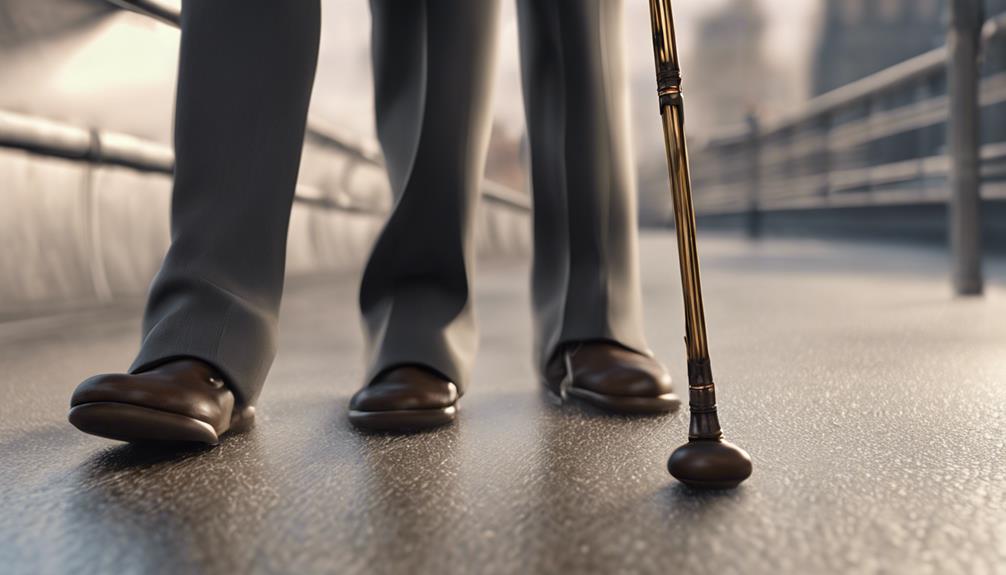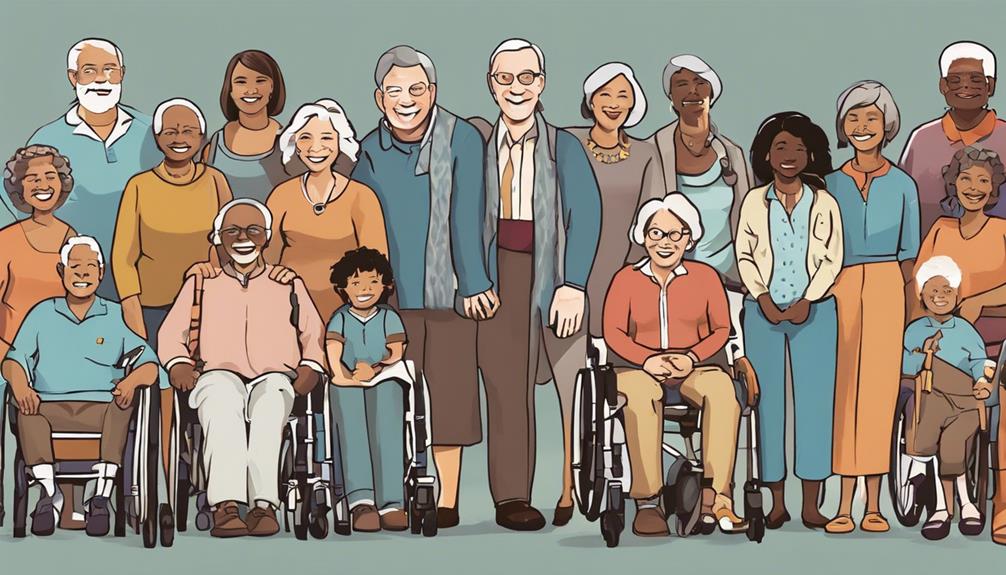Using canes strategically improves balance and effectively shifts weight to prevent falls. Canes provide an extra point of contact with the ground, enhancing stability and reducing the risk of tripping. Maintaining correct posture and alignment while standing with a cane helps alleviate joint pressure and promotes awareness of fall prevention. Navigating uneven surfaces with a cane can help increase stability on slopes and slippery surfaces, aiding in preventing slips. Canes not only help prevent falls, but also boost confidence and independence in daily activities. Further information on the advantages of using canes for fall prevention and mobility can be found.
Key Takeaways
- Canes distribute weight effectively, reducing the risk of falls.
- They provide an additional point of contact with the ground for stability.
- Canes promote safer mobility by aiding in balance and support.
- Proper cane use enhances confidence, preventing stumbles and falls.
- Canes offer independence and safety, decreasing the likelihood of falls.
Importance of Proper Posture
Maintaining proper posture when using a cane is essential for distributing weight evenly and reducing the risk of falls. Correct posture guarantees ideal balance, stability, and body alignment.
By standing upright with the cane, joint pressure is relieved, enhancing overall stability. Improving body posture not only supports better weight distribution but also promotes visibility and awareness of one's surroundings, essential for fall prevention.
When the body is aligned correctly, the cane becomes an extension of support, aiding in maintaining an upright stance. This upright stance not only assists in distributing weight effectively but also helps in overcoming obstacles with increased confidence.
Hence, paying attention to body posture while using a cane is key to maximizing its benefits in relation to stability, balance, and fall prevention. Remember, a proper posture not only supports physical well-being but also boosts confidence and independence in daily activities.
Enhanced Stability and Support

Enhancing stability and support is a primary function of using canes, as they redistribute body weight and reduce the risk of losing balance. When using a cane for stability, it's essential to understand how it provides support and aids in preventing falls. Here are three key aspects to take into account:
- Improved Equilibrium: Canes offer a wider base of support, enhancing equilibrium during movement. By increasing the area of support, canes help in balancing the body weight effectively, reducing the chances of losing balance and falling.
- Enhanced Gait Patterns: Canes assist in improving gait patterns by providing additional support for weaker legs. This support helps in maintaining proper walking techniques and reduces the risk of stumbling or tripping, ultimately preventing falls.
- Reduced Fatigue: By decreasing the load on lower extremities, canes help in minimizing fatigue during walking. This reduction in fatigue not only improves overall mobility but also decreases the likelihood of falls due to tired muscles.
Reducing Tripping and Stumbling
Canes play an important role in minimizing the risk of tripping and stumbling, contributing to overall fall prevention by providing stability and support. When walking with a cane, it helps in reducing tripping by enhancing stability and balance.
The cane acts as a support system, aiding in weight distribution and relieving strain on muscles and joints. By assisting with maintaining proper posture and alignment, canes decrease the chances of stumbling. It's vital to use the cane on the side opposite to your weaker leg to provide the necessary support.
When encountering obstacles or uneven surfaces, the cane can help navigate these challenges, preventing falls that may result from tripping. Pay attention to your gait while using the cane, ensuring a smooth and steady stride. Remember that proper use of the cane not only reduces the risk of tripping but also enhances overall stability, making each step safer.
Navigating Uneven Terrain Safely

Canes play an essential role in maintaining stability on slopes and balancing on gravel. They help distribute weight effectively, assisting in maneuvering uneven terrain with greater ease.
Stability on Slopes
Traversing uneven terrain safely, especially on slopes, requires utilizing a cane to distribute weight evenly and maintain balance to prevent slips and falls. When moving on slopes with a cane, consider these key tips for stability and safety:
- Proper Positioning: Position the cane on the side of your body facing the slope to enhance stability and support during uphill or downhill movement.
- Nonskid Rubber Tips: Opt for canes with nonskid rubber tips to improve traction on slopes, reducing the risk of sliding on challenging surfaces.
- Weight Distribution: By assisting in weight distribution and providing a point of contact for stability, canes play an important role in preventing falls on uneven terrain like slopes.
Balancing on Gravel
Traversing uneven terrain like gravel requires maintaining balance and stability to prevent slips and falls. Canes play an essential role in moving through such surfaces by providing the necessary support and stability.
When walking on gravel with a cane, make sure the rubber tip grips the ground firmly to enhance traction and reduce the risk of slipping. By using a cane, you can distribute your weight more evenly, which helps prevent tripping and falling. The extended base of support offered by the cane allows for better stability and confidence while walking on gravel.
Improving Confidence and Independence
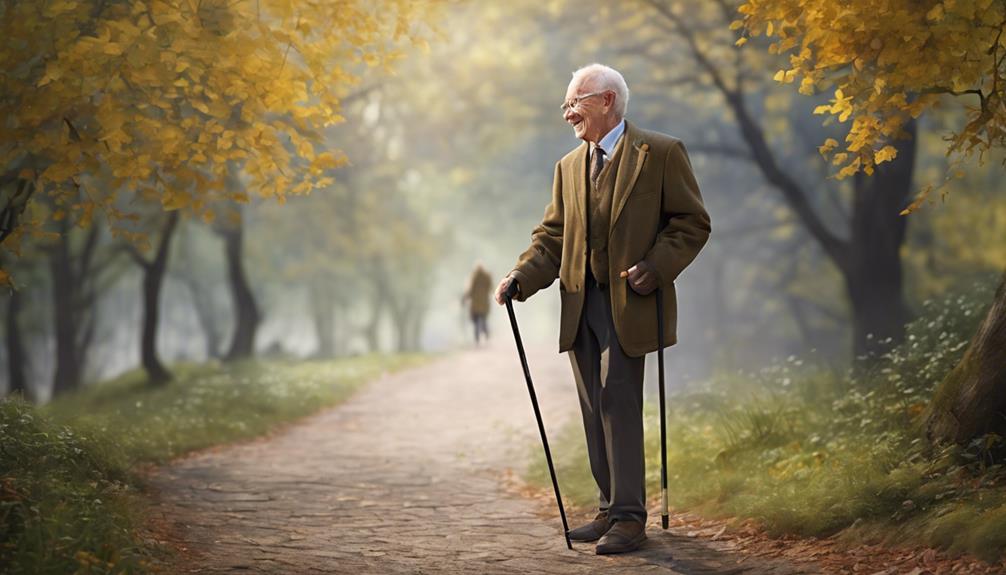
Enhancing one's confidence and independence is achievable through the use of a cane, providing stability and support for improved mobility and daily activities. Using a cane can greatly impact one's sense of self-assurance and capability.
Here are three ways canes help in improving confidence and independence:
- Enhanced Stability: Canes offer stability while walking, helping individuals maintain balance and preventing falls. This stability gives users the assurance to move around more freely and independently.
- Increased Support: By providing support, canes help individuals navigate various terrains and environments with more confidence. This support reduces the fear of falling and encourages independence in daily activities.
- Improved Mobility: Proper use of a cane can enhance mobility, allowing individuals to move around more easily and engage in a wider range of activities. This increased mobility boosts confidence and promotes independence in everyday life.
Role in Fall Prevention Strategies

In implementing fall prevention strategies, canes play a crucial role by providing additional support and stability to individuals at risk of falling. Canes aid in redistributing weight, enhancing balance, and decreasing the likelihood of losing balance and experiencing a fall. By supporting a portion of the body weight and offering a secure base for walking, canes help lessen the impact of falls.
Research indicates that not using canes during falls can lead to more severe injuries, underscoring the necessity of incorporating canes into daily routines for injury prevention. When integrated into fall prevention programs alongside interventions like strength training and environmental modifications, canes greatly diminish the risk of falls among older adults.
Ensuring proper cane usage, maintaining the equipment, and incorporating it into daily activities can enhance stability, reduce the likelihood of falls, and contribute to a safer living environment. Canes are valuable tools in fall prevention, promoting safety and well-being for individuals at risk of falls. In addition to proper cane usage, it’s important to create a holistic approach to well-being by encouraging regular outdoor activities, where the healing power of nature can positively impact both physical and mental health. Spending time in natural environments not only boosts mood but also supports better balance and mobility, further contributing to fall prevention efforts.
Impact on Mobility and Safety
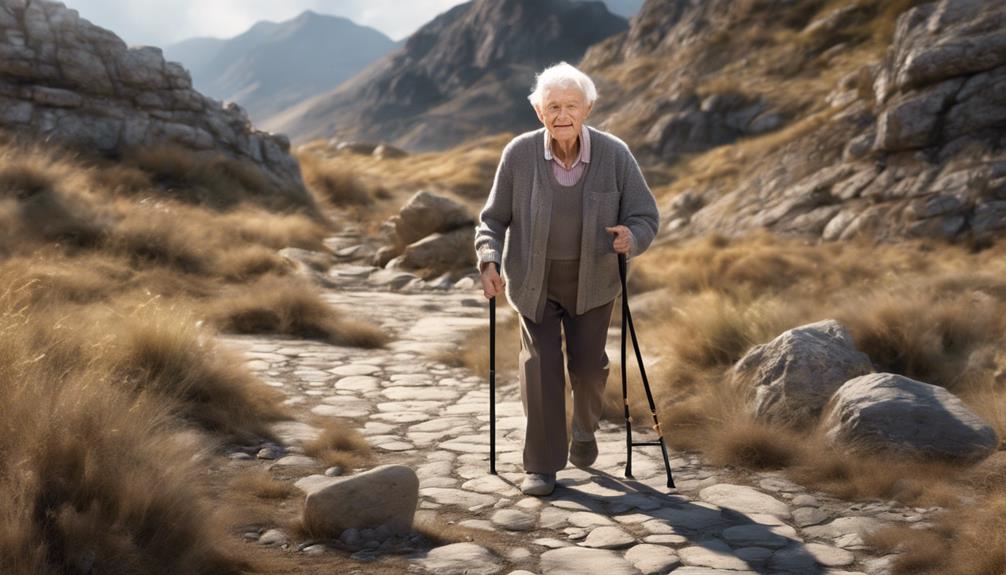
Using a cane can provide essential support for our mobility needs, helping us move around more confidently.
Additionally, the safety features of a cane can greatly reduce the chances of accidents or falls.
Mobility Support Benefits
Canes play an important role in supporting mobility and enhancing safety by providing stability and balance for older adults. When considering the mobility support benefits of canes, we must acknowledge their impact on weight redistribution, balance improvement, and injury prevention:
- Weight Redistribution: Canes help redistribute weight off the lower body, reducing strain on joints and muscles, which is especially beneficial for older adults with mobility issues.
- Balance Improvement: By acting as a walking aid, canes assist in improving balance and stability, allowing individuals to navigate daily activities with greater ease and confidence.
- Injury Prevention: Proper use of canes can significantly decrease the risk of falls and related injuries, promoting independence and enhancing overall safety for older adults.
Safety Enhancement Features
Enhancing stability and promoting safer mobility, the safety features of canes play a crucial role in supporting older adults' independence and confidence. Rubber tips on canes prevent slipping, ensuring stability on different surfaces and reducing the risk of falls.
By supporting up to 25% of the body weight, canes help redistribute pressure away from weaker limbs, improving balance and reducing the chances of stumbling. Properly sized canes also encourage correct posture and gait, enhancing overall mobility and safety.
To further prevent falls, using a cane on the side opposite the weaker leg promotes even weight distribution, offering better support during movement. These safety enhancements not only aid in fall prevention but also boost older adults' confidence in their ability to move safely and independently.
Benefits for Older Adults
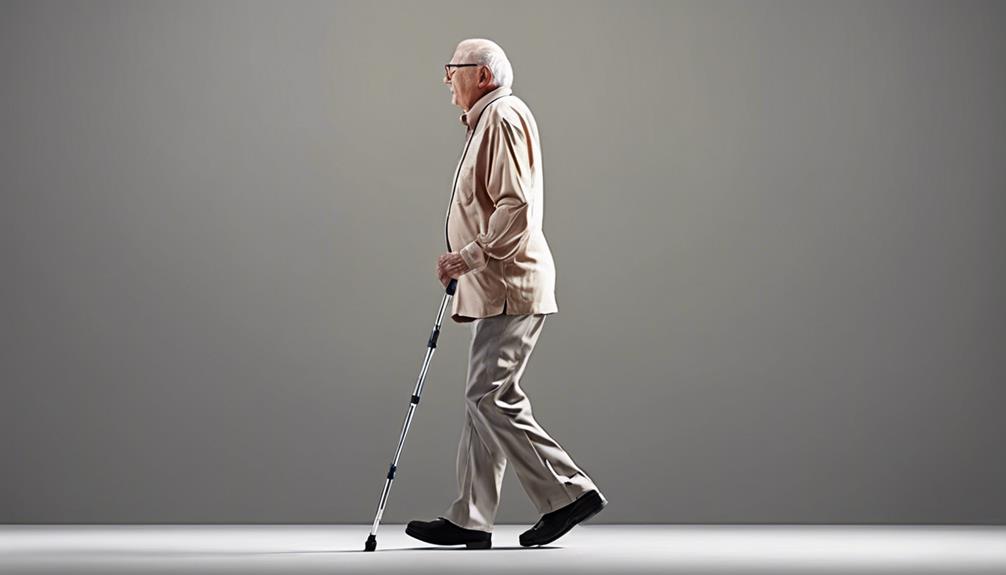
Improving stability and support for older adults, canes play an essential role in preventing falls by distributing weight effectively. Here are three key benefits of using a cane for older adults:
- Enhanced Balance: Canes assist in maintaining balance by providing an additional point of contact with the ground, reducing the chances of losing equilibrium while walking.
- Improved Mobility: Properly sized canes help relieve pressure on joints and muscles, making movement safer and more comfortable for older individuals.
- Increased Independence: By reducing the fear of falling, canes boost confidence in movement, enabling older adults to maintain their independence and engage in daily activities with greater assurance.
In addition to these benefits, canes offer a cost-effective solution to enhance mobility and prevent falls in the elderly population. Incorporating a cane into daily activities can significantly improve overall safety and well-being for older adults, promoting a more active and independent lifestyle.
Frequently Asked Questions
How Does a Cane Keep You From Falling?
Using a cane keeps us from falling by providing extra support and stability. When we hold the cane in the hand opposite our weaker leg, it helps distribute weight evenly and maintain proper balance while walking.
This assists in improving gait patterns, reducing the chance of tripping or stumbling. Canes also offload weight from the lower extremities, lessening strain on joints and muscles, which ultimately helps prevent falls.
How Do You Prevent Falls With a Cane?
When utilizing a cane to prevent falls, we guarantee proper balance and stability. By correctly positioning the cane on the side of our stronger leg, we distribute weight evenly, reducing the risk of tripping or stumbling.
Moving the cane and weaker leg in sync maintains stability and prevents falls. With a properly sized cane supporting at least 25% of our body weight, we enhance stability and minimize the likelihood of accidents.
How Does a Cane Help With Balance?
Canes help with balance by providing a wider base of support, distributing weight more evenly, and enhancing stability during walking. They improve gait mechanics, posture, and alignment.
By increasing proprioceptive feedback, canes help adjust to terrain changes, reducing stumbling. Properly sized and used canes boost confidence, independence, and prevent falls in older adults.
These benefits combine to offer significant support in maintaining balance and preventing falls.
Do Walking Sticks Help Prevent Falls?
Yes, walking sticks can help prevent falls by providing crucial support and stability while moving. They distribute weight evenly, improving balance and reducing the risk of falls.
Studies show that walking sticks greatly decrease the chances of falling and related injuries in older adults. By enhancing mobility and confidence, walking sticks play an essential role in ensuring safety and independence during daily activities.
Can Canes Be a Useful Tool in Preventing Falls?
Yes, canes can be a useful tool in preventing falls. By providing extra support and stability, canes can help individuals maintain their balance and reduce the risk of slipping or losing their footing. In addition to using a cane, there are other complete fall prevention tips that can help promote safety and independence.
Conclusion
To sum up, canes play a vital role in preventing falls by providing stability, support, and confidence to individuals.
For instance, Sarah, an older adult, was able to navigate her daily walk with ease and confidence using a cane, avoiding potential hazards and maintaining her independence.
By incorporating a cane into daily activities and following proper usage techniques, individuals can greatly reduce their risk of falls and improve their overall safety and mobility.
